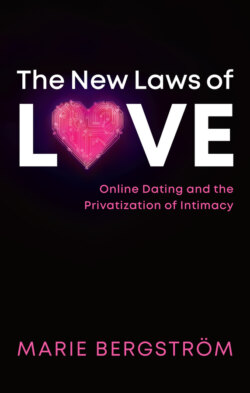Читать книгу The New Laws of Love - Marie Bergström - Страница 9
Introduction
ОглавлениеMatch, Meetic, OkCupid, Grindr, LoveScout, Tinder, Happn, Bumble… These are just a few of the thousands of dating platforms available online today. The first website to specialize in matchmaking appeared in the United States in the mid-1990s and was soon to be imitated. As the internet expanded internationally, competing sites rolled out at a quick pace across North America and Europe. They were joined some twenty years later by mobile phone applications that immediately became immensely popular, especially among the young. In the past two decades, these platforms have remapped the landscape of dating across much of the western world and beyond, changing the way people meet partners, but also challenging our ideas about sex and love.
The change is remarkable. Since at least the nineteenth century, personal ads, marriage brokers, and other “lonely hearts” networks have offered their services to bring single people together and match prospective partners. Today’s dating sites and apps are the direct descendants of those earlier forms of mediated dating; in fact they have inherited many features from their ancestors. What is fundamentally new, however, is their popularity. Until the advent of the internet, the use of commercial matchmaking remained a marginal and marginalized practice. In the 1980s and 1990s, surveys carried out in the United States and in France showed that approximately fewer than 1 in 100 people had met their spouse through a matrimonial ad or agency, for example (Bozon and Heran, 1989; Laumann et al., 1994). In the ranks of the heterosexual population, to resort to such services was taboo; the companies were generally distrusted and users consisted predominantly of divorced and widowed individuals. Mediated dating was considered something of an outcast behavior in the world of dating.
Digital platforms have brought about a major shift. Dating sites and apps have become a common way of meeting partners, and this behavior has lost most of its former social stigma. Users come from all social milieus and background and, unlike older forms of matchmaking, these new ones appeal primarily to young people. The most recent survey carried out in the United States – the birthland of online dating – showed that 30% of American adults had already used a dating site or app in 2019. Among 18- to 29-year-olds, the percentage rose to 48% (Pew Research Center, 2020c). As online dating became commonplace, commercial matchmaking finally emerged from the shade, to reach a broad general public.
What made this change possible? How do we explain this unprecedented success of online dating, and what are the implications? To answer these questions is to draw a portrait of modern love and contemporary sexuality. This is the aim of the present book. By looking at dating and how it changes online, this book tells a new story of the transformation of intimacy, a story that differs considerably from what is currently said about this phenomenon.
